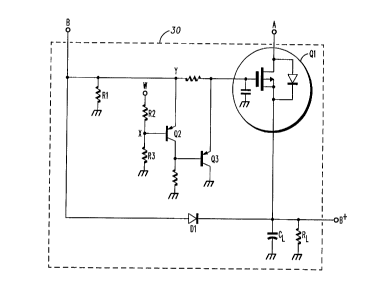Une partie des informations de ce site Web a été fournie par des sources externes. Le gouvernement du Canada n'assume aucune responsabilité concernant la précision, l'actualité ou la fiabilité des informations fournies par les sources externes. Les utilisateurs qui désirent employer cette information devraient consulter directement la source des informations. Le contenu fourni par les sources externes n'est pas assujetti aux exigences sur les langues officielles, la protection des renseignements personnels et l'accessibilité.
L'apparition de différences dans le texte et l'image des Revendications et de l'Abrégé dépend du moment auquel le document est publié. Les textes des Revendications et de l'Abrégé sont affichés :
| (12) Brevet: | (11) CA 2199214 |
|---|---|
| (54) Titre français: | DISPOSITIF DE COMMUTATION ENTRE UNE SOURCE D'ALIMENTATION EXTERNE ET UNE SOURCE D'ALIMENTATION PAR PILE PRINCIPALE |
| (54) Titre anglais: | EXTERNAL POWER SOURCE TO MAIN BATTERY POWER SOURCE SWITCH |
| Statut: | Réputé périmé |
| (51) Classification internationale des brevets (CIB): |
|
|---|---|
| (72) Inventeurs : |
|
| (73) Titulaires : |
|
| (71) Demandeurs : |
|
| (74) Agent: | GOWLING WLG (CANADA) LLP |
| (74) Co-agent: | |
| (45) Délivré: | 2000-05-16 |
| (22) Date de dépôt: | 1997-03-05 |
| (41) Mise à la disponibilité du public: | 1997-09-13 |
| Requête d'examen: | 1997-03-05 |
| Licence disponible: | S.O. |
| (25) Langue des documents déposés: | Anglais |
| Traité de coopération en matière de brevets (PCT): | Non |
|---|
| (30) Données de priorité de la demande: | ||||||
|---|---|---|---|---|---|---|
|
Circuit de commutation (30), dans un téléphone portatif, appliquant à une grille de transistor à effet de champ (Q1) une tension inférieure à la tension de seuil de la grille lorsque la tension à une première borne d'alimentation (B) tombe sous une valeur de seuil, ce qui a pour effet de couper la connexion entre la première borne d'alimentation (B) et une borne d'entrée d'alimentation du téléphone portatif (B+) et de raccorder une deuxième borne d'alimentation (A) à la borne d'entrée d'alimentation (B+). La tension de seuil est établie à un niveau supérieur à la tension d'alimentation minimale du téléphone portatif. La première borne d'alimentation peut être connectée à une pile principale et la deuxième borne d'alimentation peut être connectée à un adaptateur, p. ex. adaptateur de simulateur de pile, adaptateur mains-libres ou adaptateur d'émetteur-récepteur mobile. Le présent circuit de commutation empêche un appel en cours d'être coupé lorsque les sources d'alimentation sont changées pendant une rafale GSM.
A switching circuit (30) in a portable telephone connects a gate of a
field-effect transistor (Q1) to a voltage below the transistor's gate threshold
voltage when the voltage at a first power source terminal (B) falls below a
threshold voltage, thus disconnecting the first power source terminal (B)
from a portable telephone power input terminal (B+) and connecting a
second power source terminal (A) to the power input terminal (B+). The
threshold voltage is set at a voltage above the minimum supply voltage of
the portable telephone. The first power source terminal may be connected
to a main battery and the second power source terminal may be connected
to an adapter such as a battery eliminator adapter, hands-free adapter, or
mobile transceiver adapter. This switching circuit prevents a call in
progress from being disconnected when power sources are exchanged
during a GSM burst.
Note : Les revendications sont présentées dans la langue officielle dans laquelle elles ont été soumises.
Note : Les descriptions sont présentées dans la langue officielle dans laquelle elles ont été soumises.

Pour une meilleure compréhension de l'état de la demande ou brevet qui figure sur cette page, la rubrique Mise en garde , et les descriptions de Brevet , États administratifs , Taxes périodiques et Historique des paiements devraient être consultées.
| Titre | Date |
|---|---|
| Date de délivrance prévu | 2000-05-16 |
| (22) Dépôt | 1997-03-05 |
| Requête d'examen | 1997-03-05 |
| (41) Mise à la disponibilité du public | 1997-09-13 |
| (45) Délivré | 2000-05-16 |
| Réputé périmé | 2005-03-07 |
Il n'y a pas d'historique d'abandonnement
| Type de taxes | Anniversaire | Échéance | Montant payé | Date payée |
|---|---|---|---|---|
| Requête d'examen | 400,00 $ | 1997-03-05 | ||
| Enregistrement de documents | 100,00 $ | 1997-03-05 | ||
| Le dépôt d'une demande de brevet | 300,00 $ | 1997-03-05 | ||
| Taxe de maintien en état - Demande - nouvelle loi | 2 | 1999-03-05 | 100,00 $ | 1998-12-22 |
| Taxe de maintien en état - Demande - nouvelle loi | 3 | 2000-03-06 | 100,00 $ | 1999-12-16 |
| Taxe finale | 300,00 $ | 2000-02-21 | ||
| Taxe de maintien en état - brevet - nouvelle loi | 4 | 2001-03-05 | 100,00 $ | 2001-02-19 |
| Taxe de maintien en état - brevet - nouvelle loi | 5 | 2002-03-05 | 150,00 $ | 2002-02-04 |
| Taxe de maintien en état - brevet - nouvelle loi | 6 | 2003-03-05 | 150,00 $ | 2003-02-04 |
Les titulaires actuels et antérieures au dossier sont affichés en ordre alphabétique.
| Titulaires actuels au dossier |
|---|
| MOTOROLA, INC. |
| Titulaires antérieures au dossier |
|---|
| BARKAT, SHAKIL H. |
| BLACK, GREGORY REDMOND |